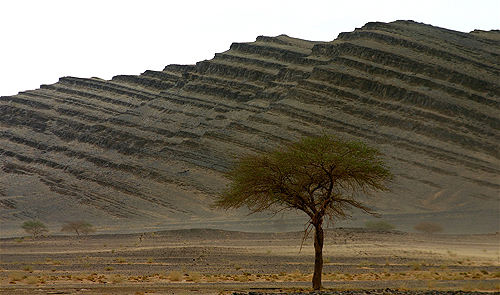The Eastern Arabian Shield: Window into Supercontinental Assembly at the Dawn of Animal Life
 The Arabian shield is a nucleus of late Precambrian crust that covers an area about twice the size of Montana on the eastern margin of the Arabian Peninsula (Fig. 1a). It is superbly exposed in this rugged, hyper-arid environment where wind-blown sand is the only cover. Along with its counterpart in Egypt—the Nubian shield—the Arabian shield formed through the accretion of volcanic arcs and microcontinents during successive closure of ocean basins beginning about 870 million years ago as the supercontinent Rodinia broke apart. This episode of primary crustal growth culminated about 550 million years ago on the eastern margin of the shield during the final convergence between western and eastern Gondwana and the closure of the Mozambique ocean during the East African and Malagasy orogenies (Fig. 1). A distinctive feature of the Arabian shield is the preponderance of sedimentary basins that formed during this interval of crustal amalgamation. Thesse basins, which range from about 650 to 550 million years old, are widespread in the eastern part of the shield, where they are filled with lightly metamorphosed volcanic and mixed carbonate-clastic sedimentary rocks. The rocks are coeval with the Huqf Supergroup in Oman, which hosts important source rocks in the highly productive salt basins in the central part of the country and it is speculated that the so-called Jibalah basins in Saudi Arabia may have been part of the same sedimentary basin. In collaboration with colleagues at the University Adelaide (Alan Collins, John Foden), the Saudi Geological Survey (Khaled Kadi), and Peter Johnson, my PhD student Grant Cox and I are working to 1) understand the tectonic origin of the basins and their connection to East African orogeny and Oman and to 2) track and calibrate late Ediacaran biospheric and biogeochemical evolution in the Mozambique ocean.
The Arabian shield is a nucleus of late Precambrian crust that covers an area about twice the size of Montana on the eastern margin of the Arabian Peninsula (Fig. 1a). It is superbly exposed in this rugged, hyper-arid environment where wind-blown sand is the only cover. Along with its counterpart in Egypt—the Nubian shield—the Arabian shield formed through the accretion of volcanic arcs and microcontinents during successive closure of ocean basins beginning about 870 million years ago as the supercontinent Rodinia broke apart. This episode of primary crustal growth culminated about 550 million years ago on the eastern margin of the shield during the final convergence between western and eastern Gondwana and the closure of the Mozambique ocean during the East African and Malagasy orogenies (Fig. 1). A distinctive feature of the Arabian shield is the preponderance of sedimentary basins that formed during this interval of crustal amalgamation. Thesse basins, which range from about 650 to 550 million years old, are widespread in the eastern part of the shield, where they are filled with lightly metamorphosed volcanic and mixed carbonate-clastic sedimentary rocks. The rocks are coeval with the Huqf Supergroup in Oman, which hosts important source rocks in the highly productive salt basins in the central part of the country and it is speculated that the so-called Jibalah basins in Saudi Arabia may have been part of the same sedimentary basin. In collaboration with colleagues at the University Adelaide (Alan Collins, John Foden), the Saudi Geological Survey (Khaled Kadi), and Peter Johnson, my PhD student Grant Cox and I are working to 1) understand the tectonic origin of the basins and their connection to East African orogeny and Oman and to 2) track and calibrate late Ediacaran biospheric and biogeochemical evolution in the Mozambique ocean.
This project is supported by National Geographic and the Saudi Geological Survey